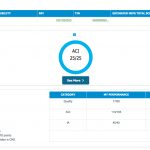These performance categories should seem very familiar to most providers; three of these categories are legacy CMS programs: PQRS, the EHR Incentive Program (Meaningful Use) and the Value-Based Modifier (VBM). The fourth category, improvement activities, is a new catch-all for other previous CMS improvement initiatives.
Early Adopters of RISE Benefit Big
As of March 15, 2018, preliminary reports show an 86% increase in rheumatologists who used RISE for quality reporting compared with the final year of reporting for the PQRS program in 2016.
Out of the providers/practices that used RISE for reporting all MIPS categories for the 2017 performance year, almost 17% submitted 100 points (maximum score) to the QPP, and 47% of practices/providers met or exceeded the 70-point exceptional threshold. Out of the maximum 60 points attainable for the quality measures category, the average score for this category submitted to CMS was 49.41.
The average MIPS Composite Score submitted to CMS for users that submitted all MIPS categories with RISE was 88.72 out of a possible 100 points This not only means that practices are obtaining the maximum benefit of this incentive program, but it underscores that rheumatologists are routinely providing high-quality care as defined by the QPP.
MIPS Performance Year 2 (2018)
The CMS estimates that 3,340 rheumatologists are MIPS eligible in 2018. This number is down from the 2017 number because the CMS increased the low-volume threshold for reporting in 2018. For the current year, if rheumatologists have less than or equal to $90,000 in Part B allowed charges or 200 or fewer Part B beneficiaries, then these providers are exempt for reporting into the QPP.2
Another substantial difference for the 2018 performance year is that the maximum payment adjustment for penalties and bonuses increases from 4% to 5%. Other key differences between the 2017 and 2018 performance year of the program are the data requirements for reporting.
The performance threshold increases from three points to 15 points in 2018. This means that providers must submit a MIPS composite score of at least 15 points to qualify for a neutral payment adjustment. CMS did maintain the exceptional performance threshold at 70 points, which is good news for RISE users who were already able to achieve a composite score of 70 or above in the first year. Further, providers had to report on 50% of their patients regardless of payer for any continuous 90 days in 2017, but rheumatologists will now have to report 60% of their patients for the entire calendar year for the Quality category.

